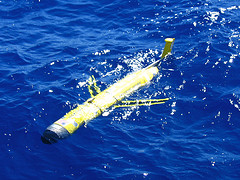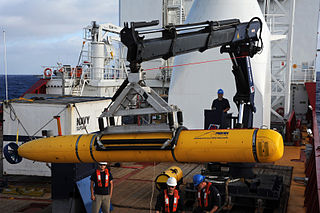Related Research Articles

A diver propulsion vehicle (DPV), also known as an underwater propulsion vehicle or underwater scooter, or swimmer delivery vehicle (SDV) by armed forces, is an item of diving equipment used by scuba divers to increase range underwater. Range is restricted by the amount of breathing gas that can be carried, the rate at which that breathing gas is consumed, and the battery power of the DPV. Time limits imposed on the diver by decompression requirements may also limit safe range in practice. DPVs have recreational, scientific and military applications.

An autonomous underwater vehicle (AUV) is a robot that travels underwater without requiring input from an operator. AUVs constitute part of a larger group of undersea systems known as unmanned underwater vehicles, a classification that includes non-autonomous remotely operated underwater vehicles (ROVs) – controlled and powered from the surface by an operator/pilot via an umbilical or using remote control. In military applications an AUV is more often referred to as an unmanned undersea vehicle (UUV). Underwater gliders are a subclass of AUVs.

An underwater glider is a type of autonomous underwater vehicle (AUV) that employs variable-buoyancy propulsion instead of traditional propellers or thrusters. It employs variable buoyancy in a similar way to a profiling float, but unlike a float, which can move only up and down, an underwater glider is fitted with hydrofoils that allow it to glide forward while descending through the water. At a certain depth, the glider switches to positive buoyancy to climb back up and forward, and the cycle is then repeated.
Sea Dragon (海龙) class remotely operated underwater vehicle is a class of Chinese ROV used to perform various underwater tasks ranging from oil platform service to salvage and rescue missions, and it is a class of ROUV developed in People's Republic of China with the deepest diving capability: up to 3,500 meters.
Explorer autonomous underwater vehicle (AUV) is a Chinese AUV developed in the People's Republic of China (PRC), first entering service in November 1994. It should not be confused with another two Anglo-American AUVs that share the same name: the American Autonomous Benthic Explorer AUV (ABE) built by Woods Hole Oceanographic Institution, and the British Columbia-based International Submarine Engineering built Canadian Explorer AUV, which is based on its earlier ARCS AUV. Explore AUV is the first member of a series of Chinese AUVs later developed, all of which are based on Explorer AUV.

The REMUS series are autonomous underwater vehicles (AUVs) made by the Woods Hole Oceanographic Institution and designed by their Oceanographic Systems Lab (OSL). More recently REMUS vehicles have been manufactured by the spinoff company Hydroid Inc. a wholly owned subsidiary of Kongsberg Maritime. The series are designed to be low cost, they have shared control software and electronic subsystems and can be operated from a laptop computer. They are used by civilians for seafloor mapping, underwater surveying, and search and recovery as well as by several navies for mine countermeasures missions.
Observer and Developer UAVs are Chinese micro air vehicles (MAV) developed by Beijing Co., Ltd. Viga Hangtong Technology Co., Ltd. , and has been deployed by various local Chinese law and governmental agencies/establishments.
Tianxiang UAVs are Chinese UAVs developed by Beijing Tianxiang Aerospace Science and Technology Co., Ltd. . Tianxiang products covers a wide range of unmanned aircraft, including paragliders, helicopters, fixed wing airplanes and blimps.
Winhye UAVs are Chinese UAVs developed by Beijing Winhye Aviation Co., Ltd. , a company that traditionally has been a provider of subsystems to other UAV manufacturers, namely, the electro-optical pods and software. Recently, Winhye has expanded its business in the UAV arena by developing its own brand of UAVs.
AUTC UAVs are Chinese UAVs developed by Tianjin Aurora UAV Technology Co., Ltd. . As of 2013, a total of four have been publicized.
PUT UAVs are Chinese UAVs developed by Beijing Pilotless UAV Technology Co., Ltd. , an original equipment manufacturer (OEM) which has traditionally been in the business of manufacturing UAV designs from other Chinese UAV developer, and providing subsystems to these other Chinese UAV developers. PUT has recently expanded its business in the UAV arena by developing UAVs of its own, which are marketed under PLT brand.
Tianyi UAVs are Chinese UAVs developed by Nanjing Tianyi Unmanned Aerial Vehicles Co., Ltd. Some of its UAVs are jointly developed with Nanjing University of Science and Technology.
TJU UAVs are Chinese unmanned aerial vehicles (UAVs) developed by Tianjin University (TJU). As an academic research and development establishment, TJU is only limited to the development of UAVs. The production and marketing of these UAVs are performed by two companies via joint development agreement with TJU, and these two companies are Noble Moral Aviation (沈阳通飞航空科技有限公司) and Dong Xin Airlines (沈阳东信科技开发有限公司), both heardquartered in Shenyang. Some of the UAVs marketed by both companies are jointly developed by TJU and Shenyang Institute of Automation of Chinese Academy of Sciences. As of 2013, all of UAVs developed by TJU and its associates are unmanned helicopters.
AI Bird UAVs are Chinese UAVs developed by Wuhan AI Bird UAV Co., Ltd. , whose products covers both the fixed wing and rotary UAVs.

The Bluefin-21 is an autonomous underwater vehicle (AUV) developed by Bluefin Robotics for defence, commercial or scientific use. It found its most famous use in April 2014 in the search for the wreckage of the missing Malaysia Airlines Flight 370.
BUAA UAVs are Chinese UAVs developed by Beihang University (BUAA), which are intended for various missions such as experimental research, reconnaissance missions, and some have since entered service with Chinese military and governmental establishments.

Maya AUV is an autonomous underwater vehicle (AUV), developed by the Marine Instrumentation Division at the National Institute of Oceanography (NIO), India.
Echo Voyager is an autonomous underwater vehicle (AUV) built by Boeing.
Echo Seeker is an autonomous underwater vehicle (AUV) built by Boeing.